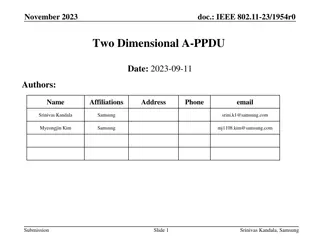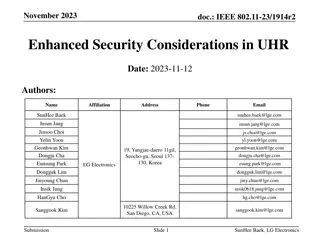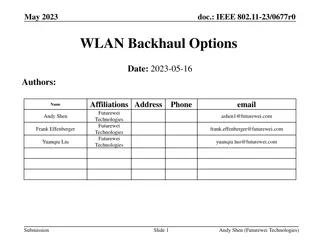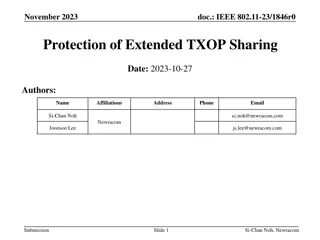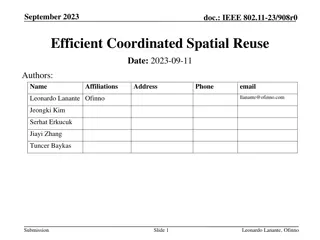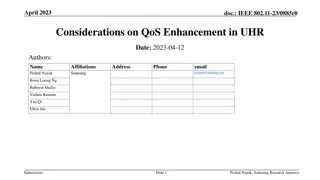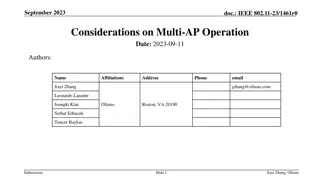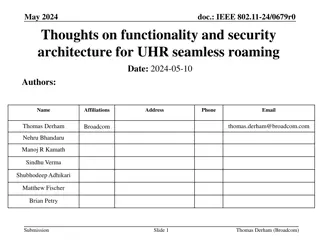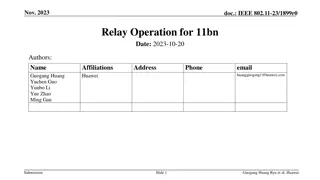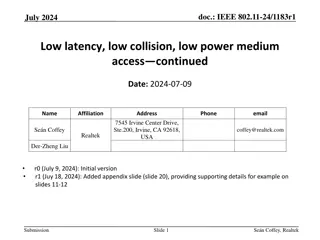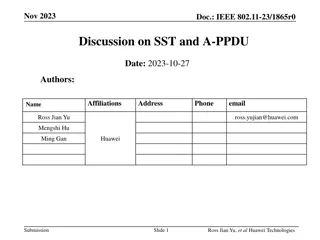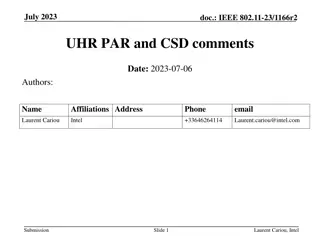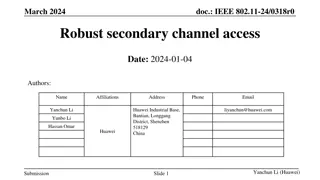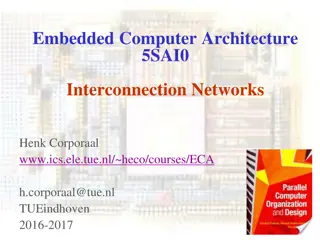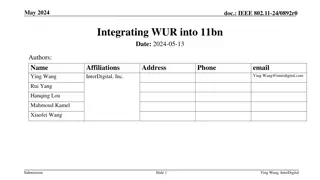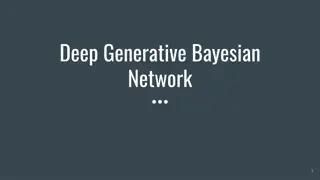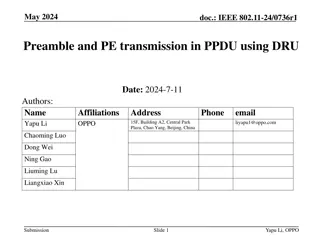Computational Physics (Lecture 18)
Neural networks explained with the example of feedforward vs. recurrent networks. Feedforward networks propagate data, while recurrent models allow loops for cascade effects. Recurrent networks are less influential but closer to the brain's function. Introduction to handwritten digit classification
0 views • 55 slides
Evolution and Potential of 5G Technology
Explore the evolving landscape of 5G technology, from enhanced mobile broadband to groundbreaking use cases and standalone networks. Learn how supportive regulations and spectrum allocation are vital for unlocking 5G's full potential. Discover the transformative impact of Standalone 5G networks on i
8 views • 10 slides
Efficient dRU Tone Plan Design for UHR Communications
The document discusses the signaling techniques for Ultra-High Rate (UHR) communications using dRU (dense RU) for overcoming PSD limitations. It elaborates on the methods to construct a dRU tone plan and indicate dRUs within rRUs. The design involves defining different sizes of dRUs, combining tones
0 views • 28 slides
Understanding Computer Networks: Types and Characteristics
In the realm of computer networks, nodes share resources through digital telecommunications networks. These networks enable lightning-fast data exchange and boast attributes like speed, accuracy, diligence, versatility, and vast storage capabilities. Additionally, various types of networks exist tod
9 views • 12 slides
Graph Neural Networks
Graph Neural Networks (GNNs) are a versatile form of neural networks that encompass various network architectures like NNs, CNNs, and RNNs, as well as unsupervised learning models such as RBM and DBNs. They find applications in diverse fields such as object detection, machine translation, and drug d
2 views • 48 slides
Two-Dimensional A-PPDU for Low Latency in UHR Networks
This document discusses the proposed two-dimensional (2D) A-PPDU as a solution for supporting low-latency applications in UHR networks. It delves into the details of 2D A-PPDU for downlink, focusing on the ability to insert PPDUs within a PPDU, aiming to reduce latency in UHR environments by enhanci
0 views • 17 slides
Enhanced Security Considerations in IEEE 802.11-23 for UHR
The document discusses enhanced security considerations for control frames and MAC headers in IEEE 802.11-23 addressing vulnerabilities and proposing encryption/decryption methods. It highlights the need for support for security protocols in control frames and the importance of protecting MAC header
0 views • 13 slides
Understanding Artificial Neural Networks From Scratch
Learn how to build artificial neural networks from scratch, focusing on multi-level feedforward networks like multi-level perceptrons. Discover how neural networks function, including training large networks in parallel and distributed systems, and grasp concepts such as learning non-linear function
1 views • 33 slides
Understanding Back-Propagation Algorithm in Neural Networks
Artificial Neural Networks aim to mimic brain processing. Back-propagation is a key method to train these networks, optimizing weights to minimize loss. Multi-layer networks enable learning complex patterns by creating internal representations. Historical background traces the development from early
1 views • 24 slides
WLAN Backhaul Options for Next-Generation Wi-Fi Networks
IEEE 802.11-23/0677r0 explores various backhaul options for WLAN, emphasizing Fiber to the Room (FTTR) technology based on Passive Optical Network (PON) for enhancing the performance of multi-AP coordinated next-gen Wi-Fi UHR. The document discusses wired and wireless backhaul connections, including
2 views • 15 slides
Exploring Samsung SmartThings Hub and Zigbee/Zwave Networks
The Samsung SmartThings hub is a versatile device connecting Zigbee and Zwave networks, offering secure access to SkySpark via HTTPS. Zigbee and Zwave networks operate on distinct frequencies, enabling efficient communication without interference with WiFi. These networks support various devices for
0 views • 19 slides
Protection of Extended TXOP Sharing in IEEE 802.11-23/1846r0
Reusing EHT's Triggered TXOP Sharing framework for extended TXOP sharing is discussed in this document, focusing on enabling sharing APs to distribute their obtained TXOP among other BSS(s). The document explores issues related to TXOP sharing for UHR STAs when a sharing AP allocates a portion of it
0 views • 12 slides
Understanding Wireless Wide Area Networks (WWAN) and Cellular Network Principles
Wireless Wide Area Networks (WWAN) utilize cellular network technology like GSM to facilitate seamless communication for mobile users by creating cells in a geographic service area. Cellular networks are structured with backbone networks, base stations, and mobile stations, allowing for growth and c
2 views • 17 slides
Understanding Interconnection Networks in Multiprocessor Systems
Interconnection networks are essential in multiprocessor systems, linking processing elements, memory modules, and I/O units. They enable data exchange between processors and memory units, determining system performance. Fully connected interconnection networks offer high reliability but require ext
1 views • 19 slides
Understanding Computer Networks in BCA VI Semester
Computer networks are vital for sharing resources, exchanging files, and enabling electronic communications. This content explores the basics of computer networks, the components involved, advantages like file sharing and resource sharing, and different network computing models such as centralized a
1 views • 96 slides
Efficient Coordinated Spatial Reuse in IEEE 802.11-23
Coordinated Spatial Reuse (C-SR) is a Multi-AP transmission technique proposed for UHR networks that enhances efficiency by utilizing RSSI or pathloss feedback instead of complete CSI. This document introduces an efficient protocol for C-SR, focusing on a unified approach for better implementation.
0 views • 10 slides
Understanding Computer Communication Networks at Anjuman College
This course focuses on computer communication networks at Anjuman College of Engineering and Technology in Tirupati, covering topics such as basic concepts, network layers, IP addressing, hardware aspects, LAN standards, security, and administration. Students will learn about theoretical and practic
0 views • 72 slides
Enhancing Quality of Service in Ultra High Rate Wi-Fi Networks
This document explores the potential improvements in Quality of Service (QoS) for Ultra High Rate (UHR) Wi-Fi networks, focusing on the benefits of timing information sharing for traffic urgency assessment. It discusses areas such as increased reliability, lower latencies, improved manageability, an
0 views • 11 slides
Introduction to Neural Networks in IBM SPSS Modeler 14.2
This presentation provides an introduction to neural networks in IBM SPSS Modeler 14.2. It covers the concepts of directed data mining using neural networks, the structure of neural networks, terms associated with neural networks, and the process of inputs and outputs in neural network models. The d
0 views • 18 slides
Enhancing Agriculture Through Global Knowledge Networks and Information Management Systems
Global and regional knowledge networks play a vital role in agriculture by facilitating information sharing, collaboration, capacity building, and coordination among stakeholders. These networks improve access to information, foster collaboration, enhance capacity building, and strengthen coordinati
0 views • 5 slides
Considerations on Multi-AP Operation in IEEE 802.11-23/1461r0
This document discusses considerations for multi-AP operation within IEEE 802.11 standards, focusing on selecting transmission schemes and scheduling for optimal performance. It explores the phases involved in multi-AP setup, coordination, selection, channel sounding, data sharing, and data transmis
0 views • 12 slides
Understanding Router Routing Tables in Computer Networks
Router routing tables are crucial for directing packets to their destination networks. These tables contain information on directly connected and remote networks, as well as default routes. Routers use this information to determine the best path for packet forwarding based on network/next hop associ
0 views • 48 slides
P-Rank: A Comprehensive Structural Similarity Measure over Information Networks
Analyzing the concept of structural similarity within Information Networks (INs), the study introduces P-Rank as a more advanced alternative to SimRank. By addressing the limitations of SimRank and offering a more efficient computational approach, P-Rank aims to provide a comprehensive measure of si
0 views • 17 slides
UHR Seamless Roaming: Functionality and Security Architecture Proposal
Discussion on the technical requirements for UHR seamless roaming, focusing on the non-AP MLD state preservation and data exchange context between AP MLDs. Proposing a security architecture based on FT to achieve seamless roaming while cautioning against sharing PTK(SA) across multiple AP MLDs. Emph
0 views • 34 slides
Understanding Advanced Classifiers and Neural Networks
This content explores the concept of advanced classifiers like Neural Networks which compose complex relationships through combining perceptrons. It delves into the workings of the classic perceptron and how modern neural networks use more complex decision functions. The visuals provided offer a cle
0 views • 26 slides
IEEE 802.11-23/1899r0 Relay Operation for 11bn - Presentation Summary
In this presentation, the IEEE 802.11-23/1899r0 document discusses relay operations to improve Rate-vs-Range (RvR) performance for UHR. Various potential solutions for implementing a relay protocol in UHR are explored, focusing on enhancing multi-hop channel access delay, end-to-end QoS, and simplif
0 views • 10 slides
Understanding Relational Bayesian Networks in Statistical Inference
Relational Bayesian networks play a crucial role in predicting ground facts and frequencies in complex relational data. Through first-order and ground probabilities, these networks provide insights into individual cases and categories. Learning Bayesian networks for such data involves exploring diff
0 views • 46 slides
Understanding Overlay Networks and Distributed Hash Tables
Overlay networks are logical networks built on top of lower-layer networks, allowing for efficient data lookup and reliable communication. They come in unstructured and structured forms, with examples like Gnutella and BitTorrent. Distributed Hash Tables (DHTs) are used in real-world applications li
0 views • 45 slides
Understanding Networks: An Introduction to the World of Connections
Networks define the structure of interactions between agents, portraying relationships as ties or links. Various examples such as the 9/11 terrorists network, international trade network, biological networks, and historical marriage alliances in Florence illustrate the power dynamics within differen
0 views • 46 slides
Enhancing Medium Access Efficiency in IEEE 802.11 Networks
This presentation discusses the utilization of chirp signals for Ultra High Rate (UHR) STAs to access the medium efficiently, transmit reliably at reduced power levels, and handle interference challenges in IEEE 802.11 networks. It explores the concept of chirps, their differentiation from other pro
0 views • 20 slides
Understanding Network Analysis: Whole Networks vs. Ego Networks
Explore the differences between Whole Networks and Ego Networks in social network analysis. Whole Networks provide comprehensive information about all nodes and links, enabling the computation of network-level statistics. On the other hand, Ego Networks focus on a sample of nodes, limiting the abili
0 views • 31 slides
Evolution of Networking: Embracing Software-Defined Networks
Embrace the future of networking by transitioning to Software-Defined Networks (SDN), overcoming drawbacks of current paradigms. Explore SDN's motivation, OpenFlow API, challenges, and use-cases. Compare the complexities of today's distributed, error-prone networks with the simplicity and efficiency
0 views • 36 slides
Discussion on IEEE 802.11-23/1865r0: SST and A-PPDU
The document discusses the current lack of support for SST on S160 in 11be, highlighting that 11be AP and STA do not support A-PPDU. It explores potential combinations for A-PPDU involving UHR and non-UHR HE and EHT STAs, addressing bandwidth enhancements and benefits of various scenarios. The analy
0 views • 14 slides
IEEE 802.11-23 UHR PAR and CSD Comments Review
Reviewing comments and responses on IEEE 802.11-23/1166r2 UHR PAR and CSD focusing on enhancing Ultra High Reliability in Wireless Local Area Networks (WLAN) with clarifications and modifications for project scope and objectives.
0 views • 21 slides
Overlapped Indication for Event-Based Low Latency Traffic Support in IEEE 802.11
The document discusses the importance of reducing latency in Ultra High Rate (UHR) PAR and Event Based Low Latency (LL) traffic support in IEEE 802.11 networks. It introduces the concept of preemption to enhance LL traffic handling and proposes an overlapped LL indication frame to address challenges
0 views • 13 slides
Addressing Issues in Secondary Channel Access for IEEE 802.11-24 Networks
This submission for IEEE 802.11-24 discusses the potential issues and solutions related to secondary channel access (SCA) in UHR/11bn networks. The focus is on coordinating access points (APs) and stations (STAs) to optimize channel utilization without causing interference. The challenges include de
0 views • 12 slides
Understanding Interconnection Networks in Embedded Computer Architecture
Explore the intricacies of interconnection networks in embedded computer architecture, covering topics such as connecting multiple processors, topologies, routing, deadlock, switching, and performance considerations. Learn about parallel computer systems, cache interconnections, network-on-chip, sha
0 views • 43 slides
Integrating WUR into IEEE 802.11bn for Enhanced Network Efficiency
IEEE 802.11-24/0892r0 proposes integrating Wake-Up Radio (WUR) technology into 11bn networks to improve reliability, support low latency traffic, increase peak throughput, and enhance power-saving capabilities. The WUR acts as a companion radio to the main connectivity radio, enabling power-saving w
0 views • 10 slides
Understanding Deep Generative Bayesian Networks in Machine Learning
Exploring the differences between Neural Networks and Bayesian Neural Networks, the advantages of the latter including robustness and adaptation capabilities, the Bayesian theory behind these networks, and insights into the comparison with regular neural network theory. Dive into the complexities, u
0 views • 22 slides
Preamble and PE Transmission in PPDU Using DRU
The document discusses the transmission of Preamble and Physical End with the DRU technology in PPDU for IEEE 802.11 networks. It covers various aspects such as legacy preamble, UHR-STF, UHR-LTF, PE fields, and SIG transmission. The focus is on achieving compatibility and performance efficiency in D
0 views • 13 slides





